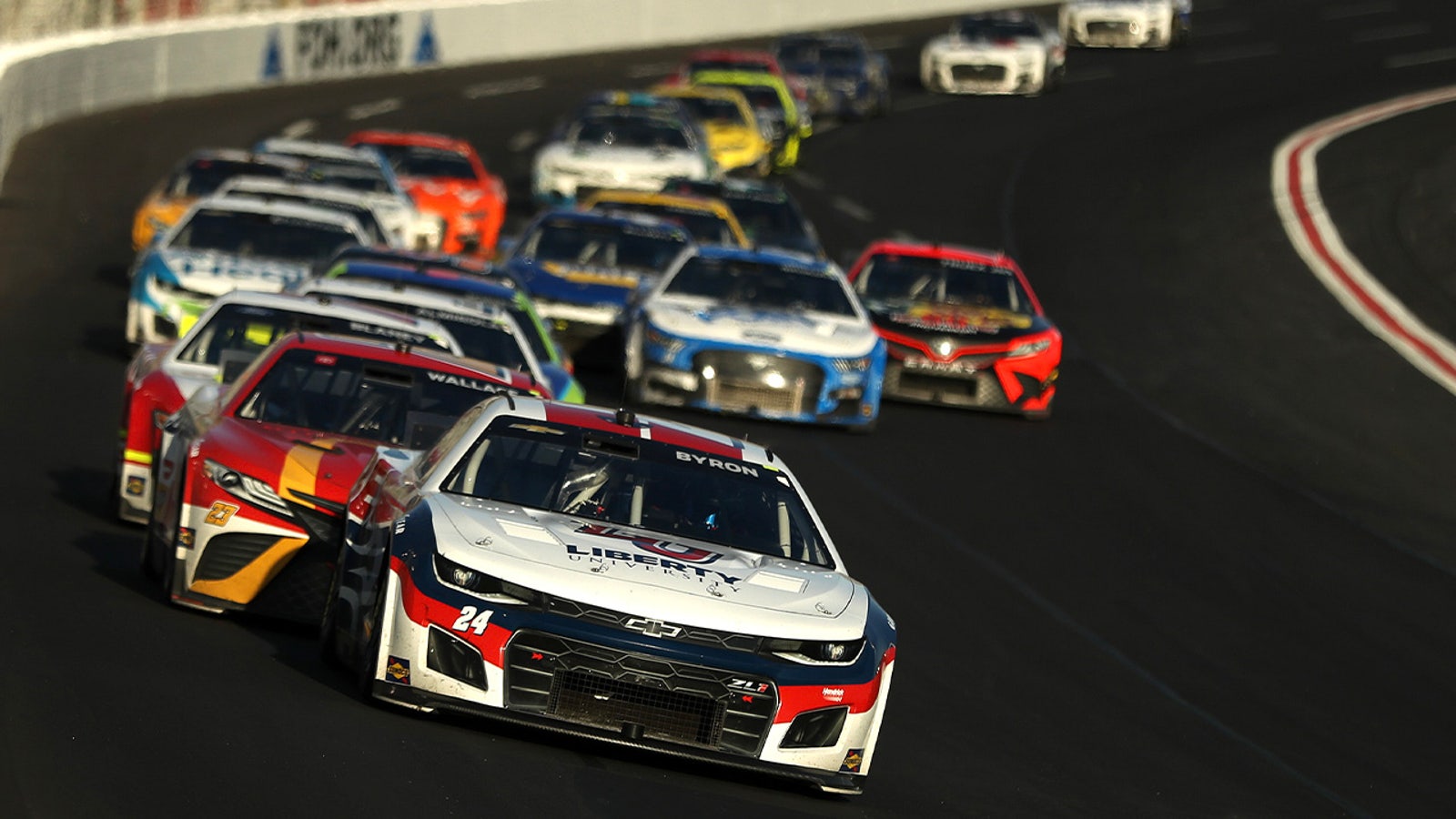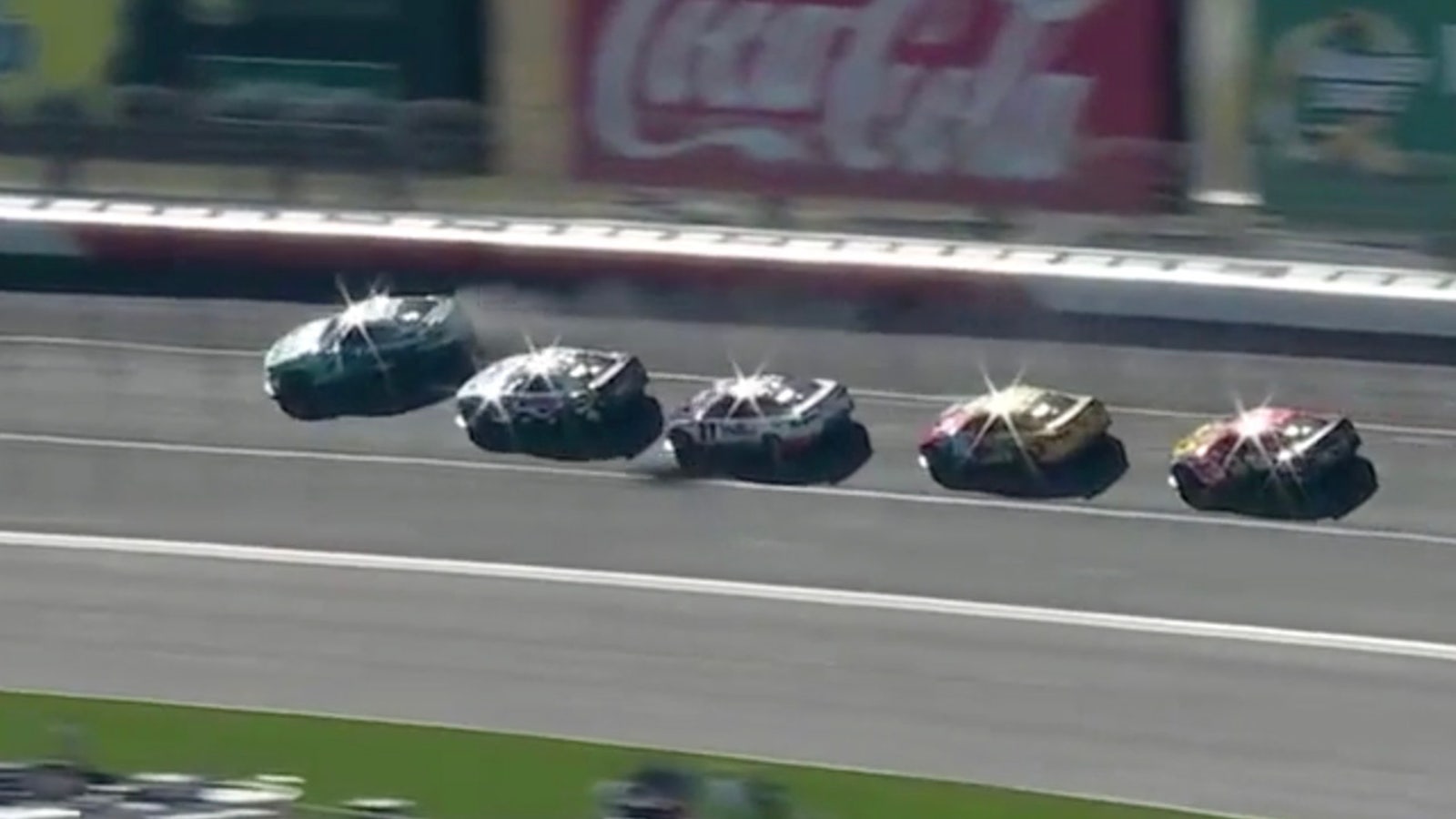
First race at Atlanta's new track brings crashes and questions
By Bob Pockrass
FOX Sports NASCAR Writer
HAMPTON, Ga. — Denny Hamlin summed up the new Atlanta Motor Speedway quite aptly after he exited the race Sunday because of an accident.
"This is what they were shooting for, so if you ask [track officials], it’s a success," Hamlin said. "I think the racing was obviously close. It’s exciting. There’s crashes. So there’s something for everyone."
Denny Hamlin describes incident with Kyle Larson
That wasn’t said as a ringing endorsement. It was more an acknowledgement of the reality that this style of racing isn’t for everyone. It creates drama, but with an inevitable propensity for more crashes and more danger.
As Speedway Motorsports tried to spice up the racing at Atlanta Motor Speedway, it increased the banking in the turns from 24 to 28 degrees, widened the front stretch slightly and significantly decreased the width in the turns and on the backstretch.
That forced NASCAR to reduce horsepower from 670 to 510 to make sure speeds were manageable, creating the kind of pack racing typically seen at Daytona and Talladega. Drivers need help from other drivers in their lane to make a pass of the other lane because of the nuances of the aerodynamic draft.
Fast Thoughts on Atlanta's new track configuration
And that’s what they got at Atlanta:
— Twenty drivers led, with 46 lead changes, both Atlanta records.
— Thirty-one of the 37 drivers were involved in accidents.
Is that a good thing? A driver's answer would probably depend on whether he finished the day at the infield care center or in the top 10.
And one driver who ran near the front much of the time and ended up in the care center enjoyed the dicey nature of the event.
"It was still really fun," Tyler Reddick said.
Tyler Reddick on the fun at Atlanta
Ricky Stenhouse Jr. indicated the same after his accident, saying that if the backstretch were a little wider, it could have produced more ability to pass.
"They got what they were looking for as far as the Daytona-Talladega-type feel," Stenhouse said.
"I really personally was still in favor of not touching Atlanta. ... I still had a blast out there today and felt like we had a car capable of winning, so can’t be mad about that, either."
Reddick and Stenhouse were among the three drivers who spent significant time near the front and blew tires. They were all in Chevrolets, leading to questions about whether the Chevrolets produced different loads, if those teams had more aggressive setups or if running out front made a big difference.
"The speed and having to run pretty much wide-open to lead, compared to 70 percent throttle, for a full lap to be second or third is definitely putting a lot more stress on the tires," said Rudy Fugle, the crew chief for the race-winning Chevrolet of William Byron.
William Byron wins at Atlanta
That is one of the issues NASCAR and Atlanta will have to work on going forward. It isn’t good if the leaders are concerned about blowing tires, Reddick said, because that could cause them to be more cautious and less aggressive.
As expected, one of the main issues seemed to be trying to avoid an accident, and not just because of the high speeds and racing in a pack. But the more narrow Atlanta, as well as it being a mile shorter than Daytona and Talladega, meant less room on the straightaways and turns to avoid an accident.
But it was even more than that. Drivers in the back of the pack had trouble manipulating the draft compared to at Daytona and Talladega.
"If you were 10th-on-back today, you're kind of just a passenger," said Daytona 500 winner Austin Cindric, who exited early after an accident.
"You can take a run and go somewhere and then go back up and take a run and go somewhere, but you wouldn’t really ever make any progress unless you put somebody three-wide. ... I never quite figured out a method to the madness."
Austin Cindric, Ricky Stenhouse Jr. make hard contact
Those who did figure it out will gladly come back in July and hope for similar results. But in hot and slick conditions, there’s no guarantee that the results (or how the tires react) will be similar. Plus, the track surface will change a little as it ages (though it already has some bumps and character).
They still will think it’s madness. The nature of a 1.54-mile, superspeedway-style race is even more intense with a 325-lap race to get to 500 miles instead of 200 at Daytona and 188 at Talladega.
Byron told his team prior to the midway point at Atlanta: "I can't believe we're not halfway yet."
"This just feels long mentally, [with] just all the energy that I'm spending to do all the moves that we need to make," Byron said. "Pretty crazy race."
How crazy? Ross Chastain was one of those drivers who blew a tire while leading, losing two laps in the process. He made them back during the race and finished second.
"To take a lick like that, blow a tire out of nowhere leading, just cruising, blow a right rear, slam the wall — I thought our day was over," Chastain said. "Our guys went underneath the car, got the tow closer, and we got the balance back where I could drive it."
Even those who were happy likely wouldn’t want to do this every week. They won't be lobbying for other 1.5-mile tracks to reconfigure in a similar way. They already have the wild races at Daytona, Talladega and Atlanta. That’s six races a year in which drivers tend to end up either with damage or in victory lane.
"I vote to cap it," Rick Hendrick said. "With our record at [these type of] races with finishing, I just think this is enough."
Looking for more NASCAR content? Sign up for the FOX Sports NASCAR Newsletter with Bob Pockrass!
Thinking out loud
NASCAR made the right call on Christopher Bell going below the red-and-white line to make a pass on the final lap.
It was close, and NASCAR probably could have swallowed the whistle. But it was clear that Bell went below and clear that he executed the pass. It could be argued that he was forced below, but it appeared that he made the move before having contact with Chastain.
Obviously the ruling was frustrating to Bell, who went from a second-place finish to 23rd — the final driver on the lead lap.
And it's tempting to think the rule isn’t needed. But several drivers have indicated that NASCAR needs to have the rule (commonly known as the "yellow-line rule") that it uses at Daytona and Talladega to keep drivers from making wild moves.
Stat of the day
Hendrick Motorsports is the second team to have three different drivers with a win through five races of a season and the first since Carl Kiekhafer Racing in 1956.
Social spotlight
They said it
"We might hit a streak here and not win one, but I'm really proud of the speed and the way they're staying up front, and hopefully we'll continue to win more races." — Rick Hendrick
Bob Pockrass has spent decades covering motorsports, including the past 30 Daytona 500s. He joined FOX Sports in 2019 following stints at ESPN, Sporting News, NASCAR Scene magazine and The (Daytona Beach) News-Journal. Follow him on Twitter and Instagram @bobpockrass. Looking for more NASCAR content? Sign up for the FOX Sports NASCAR Newsletter with Bob Pockrass!










